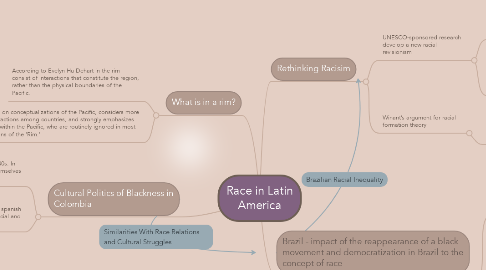
1. What is in a rim?
1.1. According to Evelyn Hu-Dehart in the rim consist of interactions that constitute the region, rather than the physical boundaries of the Pacific.
1.2. Focusing on conceptualizations of the Pacific, considers more fully interactions among countries, and strongly emphasizes peoples within the Pacific, who are routinely ignored in most discussions of the 'Rim.'
2. Cultural Politics of Blackness in Colombia
2.1. Term Afro-Mexican was found in 1940s. In mexico the Afro-Mexicans called themselves "Mexicano Negros"
2.2. African presence in Mexico 1519-1810 spanish 250,000 inslaved Africans. Both interracial and multi-cultural.
2.2.1. First town of African slaves in America was not in the US but in Yanga which is on the Mexico's Gulf Coast.
3. Rethinking Racisim
3.1. UNESCO-sponsored research develop a new racial revisionism
3.1.1. Theoretical perspectives particularly Bahia and Sao Paulo with the focus concept of racial democracy
3.1.1.1. Researchers included Thales de Acevedo, Roger Bastide, Florestan Fernandes and Marvic Harris documented racial discrimination and the ideology of "whitening"
3.1.1.1.1. Fernando's work is known to be one of the most comprehensive sociology of race relations in Brazil. Azevedo found evidence of class conflict was replacing racial conflict in Bahia. Harris worked with Acevedo suggested the system of racial identification necessarily subordinated race to class.
3.1.2. New term for debate constituting a new racial "revisionism". This was full of insights into Brazilian racial dynamics with significant limitations.
3.2. Winant’s argument for racial formation theory
3.2.1. The issue of race is the Brazilian political democracy stage: First conflict was racial inequality, mobility and redistribution of race, racially based on political action. The second is meaning of race, nature of racial identity, the logic of racial categories, the centrality of African current in Brazilian culture and history including links between blacks in Brazil.
4. Brazil - impact of the reappearance of a black movement and democratization in Brazil to the concept of race
4.1. Race: Slavery began a 100 years before US. Last longer then the US. Brazil imported 10-12 times more then the US. Brazils idea was to whiten the population by European immigration. Brazil wanted to show that it was possible to get over the slavery acts by mixing the race of the country.
4.1.1. Racial Problem: Color issues. The ideas that money whitens. Racial democracy of becoming more white through marriage, etc. because it is to be believed that white is better.
4.1.1.1. EX: Brazil has the first black college. To bring together the poorest of the poor with others to show that there is more to life then the way they are currently living. Get them to use computers for the first time, understanding business.
4.2. Brazil is and was a Racial Democracy. 80 million is Black decent. Color blind society. The belief is that color is a level of class not race discrimination.
4.2.1. Civil rights movement in Brazil: Creola Womens group. The first person to be a PHD, lawyer, etc, Black institutions like organizations like Saint Jele Dez helped make the difference in civil rights movement.
4.2.2. Law is also helping fix racial democracy. Law recognition about race. Laws are declaratory. Provides tools to solve the problem.

